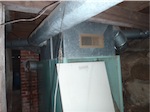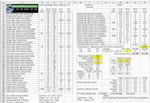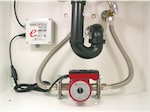The harmful effects of pesticides and other toxins on our environment are increasingly in the news. Because of our tropical climate we have more pests and diseases than most areas and therefore use more pesticides, fungicides and fertilizers.
A new and better approach to insect and disease management is replacing the practice of spraying everything in the yard on a set schedule. It is called integrated pest management or IPM. The idea is to use many methods to manage pests and ultimately use less pesticides.
These methods include:
1. Mechanical method: Picking caterpillars off the shrubs and stepping on them. Or pruning off diseased wood. Pulling weeds from the garden.
2. Physical methods: Using heat, cold, light, etc. For example, you can heat soil to kill pathogens in it or use cold to prevent food organisms from growing.
3. Biological methods: Learn your beneficial insects such as ladybugs, earwigs, etc. Attract birds to your yard by planting diverse and native species to create an ecosystem.
4. Cultural methods:- Practices in the yard include fertilization, irrigation, mulching, soil preparation and sanitation (removing diseased wood or leaves from the site). Avoid extremes of fertilizer and water. Too much or too little can weaken plants and invite pest problems.
5. Host plant resistant method: Plant varieties developed to be resistant to damage by certain pests. An example is the Floratam variety of St. Augustine grass. It is more resistant to chinch bugs than other varieties. Also help by planting shrubs and trees where conditions will be favorable for their growth.
6. Regulatory methods: Laws were established to control movement of plants and animals infested with certain pests and diseases from place to place. An example is the quarantining of areas with citrus canker.
7. Chemical methods: Including pesticides, repellents and attractants. Try to use pesticides which are not as harmful to the beneficial insects like BT, horticultural oils, and insecticidal soaps. Tolerate a few pests and a little damage. The pests are a source of food for beneficial insects that you want to keep around.
When using integrated pest management in your yard proper identification of insects is a must. There are many books available with pictures and information on the insects of Florida. A very good one is titled “Florida Insects” and costs under Five Dollars. The Collier County Extension Office in Immokalee has excellent literature on Florida insects as well.
Learn your yard and scout it regularly. Learn the beneficial insects which will feed on the harmful pests and learn to recognize when they are doing their job. If aphids, scale or whitefly nymphs have a small pinhole they have been parasitized by a tiny parasitic wasp. If you detect predators every effort should be made to preserve them. Allow the beneficial insects to control the pest population before applying insecticides. Most plants in the landscape are over sprayed resulting in unnecessary environmental contamination and often upsetting the natural predator/pest balance. Spray only when a pest population is present and damage is beginning to occur.
Pests of ornamentals are grouped according to the way they damage plants.
Insects with piercing-sucking mouthparts: They have beaklike mouthparts used for piercing the plant tissue and sucking plant juices. Examples: scales, aphids, whiteflies, mealybugs, thrips, lacebugs.
Foliage feeding insects: They feed on the leaves, flowers or roots. Examples: caterpillars, beetles, grasshoppers.
Spider mites: These pests are not insects but closely related to spiders and scorpions. They suck plant juices with piercing sucking mouthparts.
Leaf miner: These are small larvae of flies, beetles or moths that tunnel between leaf surfaces.
Borers: These are either the larvae of moths or beetles which bore into twigs and trunks of plants.
If a population of pests gets out of control use a garden hose and direct a strong spray of water at the stems and undersides of leaves of the plant to lower the pest population.
If you do have to spray try to use the less toxic products such as insecticidal soap. Or Neem insecticide, a derivative of the neem tree, which acts as a reproductive and feeding inhibitor/disrupter, growth regulator. Pyrethrins from chrysanthemums will paralyze and kill insects. Another product line uses potassium salts of fatty acids which penetrates the outer shell of soft bodied insect pests causing dehydration and death within hours. Oils which smother the insects. And Bacillus thuringiensis, Dipel or Thuricide, a natural bacterium for control of moth or butterfly larvae.
Insecticides may be required to control pests when they reach damaging levels on the plants. Before using a chemical insecticide you should consider the following points.
1. Select the right material. Only use an insecticide that is recommended to control the target pest and is safe on the host plant.
2. Use the right amount. Too little won’t control the pest and too much may injure the plant. Read the label for the correct dosage rate.
3. Apply it the right way. Thorough coverage of leaves, especially the underside, twigs and branches is essential. The insecticide must reach the area where the pest is feeding. Use of a spreader sticker will aid in the pesticide adhering to the leaves for better coverage and control.
Systemic insecticides are absorbed by the host plant and translocated throughout the tissues which makes the plant toxic to certain mite and insect pests for up to six weeks or as much as six months. They can be taken up by the roots when applied in granular form or absorbed by foliage or stems using sprays or injections. Systemic insecticides are effective in controlling sucking pests and mites. Most do not give satisfactory control of chewing insects. An example of a systemic insecticide is Merit.
Malathion is effective for controlling sucking insects. Sevin controls a wide range of chewing insects. Kelthane controls mites. Lindane, now no longer available, was for borers and leaf miners. You will have to search for a new product for these insects. Read labels to identify which plants these sprays can be safely used on.
Phytotoxicity, or plant injury, can be caused by certain pesticides on certain plants. The degree of injury can be affected by conditions like temperature, humidity and other environmental factors. It is best to apply pesticides during the cooler part of the day. Plants are less likely to be injured when protected by partial shade as opposed to being in direct sun. Some materials can injure plants that are stressed for moisture. Plants should be well watered a day or two in advance of being treated with insecticides. Above all else remember to read the label.
If you use a professional spray company you should ask them about an IPM program which would include scouting services and applying pesticides only as needed. Often you will be paying for knowledge not chemicals. Don’t allow routine blanket sprays in your yard. And be prepared to pay for their time even if they don’t spray any chemicals during the visit.
The benefits include less exposure to the pesticide for users and homeowners. Reduced exposure to fish and wildlife. Reduced pollution to our water, air and soil. And finally, we will all benefit from a cleaner environment.
for details.
- Home
- Blog
- Forum
- Green Home Topics

- »Healthy Home
- »Water Conservation
- »Energy Efficiency
- »Materials & Products
- »Resources
- Videos
- »From the Experts
- Remodeling with Passive House Approach
- How to Choose an Advanced Water Heater
- Choosing A Whole-House Ventilation System
- Selecting High Performance Windows
- Toward Zero Energy at Home - A Personal Example
- Remodel to Passive House Standards
- An Introduction to Ecological Landscaping
- Weingarten House at San Benancio - Energy
- A Deep Energy Retrofit Project
- Directory
- Events/News

- Shop
- About Us





